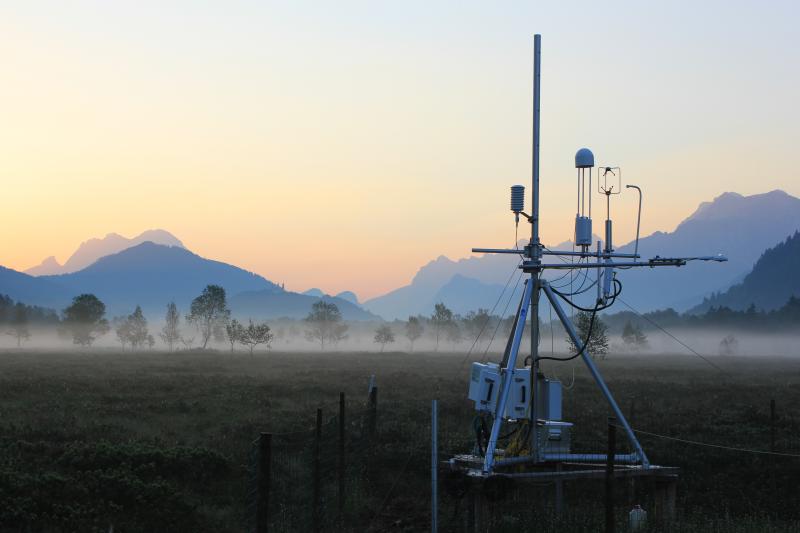Pürgschachen Moor (Regular)
Operator: Geoecology, Department of Geography and Regional Research, University of Vienna
DEIMS-SDR Database: Pürgschachen Moor
Contact: Stephan Glatzel, Andreas Maier
Site description
The Pürgschachen Moor is located on the bottom of the Styrian Enns valley, about 1.5 km southwest of the village Ardning in the district of Liezen at an altitude of 632 m a.s.l. It is a pine peat bog with a present extent of about 62 ha. Thus, it is the biggest (to a large part) intact valley peat bog of Austria with a closed peat moss cover and a good example of the formerly widely distributed peatlands of inner-alpine valleys. The peat bog site is property of the Benedictine monastery Admont and is leased to the Moorschutzverein Pürgschachen for an indefinite period of time. An EU Life-project was conducted in the years 1995 to 1998. Since 1991, the peat bog is part of the international and intergovernmental treaty of the Ramsar Convention, constituting a convention on wetlands for the conservation and wise use of wetlands and their resources. As a part of the network of nature protection areas Natura 2000 the site is protected as European nature reserve and mentioned as Important Bird Area.
Genesis of such valley floor bogs is owed to the incurrence of postglacial lakes on impermeable loamy clay. The open water surfaces silt up due to the sedimentation of dead plant material. Therefore, peat bogs with a peat depth up to 6 meters could evolve from these terrestrialisation mires in the course of time. Mean average temperature of Admont is 6.6°C, annual precipitation is 1400 mm (1971-2000). The typical vegetation of the peat bog is constituted of the three associations of plants Pino mugo-Sphagnetum magellanici (pine peat bog association), Sphagnetum magellanici (coloured bog moss association), and Caricetum limosae (bog sedge association), depending on the prevailing hydrological (local) site conditions. The peat material of the peat bog can be separated into three different peat layers: Muddy-peaty deposits, Carex-rich Sphagnum-Eriophorum-peat, and Ericaceous-poor Sphagnum-Eriophorum-peat.

The focus of our research at the study area Pürgschachen Moor is the investigation of carbon fluxes and a full carbon balance measured by eddy covariance technique. Based on the sampling of undisturbed peat cores potential gas releases measured in the laboratory can be compared with the data measured in field. The examination of peat properties, water table measurements, vegetation surveys, and climate data are further important variables. The Pürgschachen Moor is the first peat bog in the Alpine region getting investigated in detail regarding its carbon budget and is supposed to provide extensive information for the assessment and differentiation of alpine peat bogs.
Publications
- Müller, R.; Maier, A.; Inselsbacher, E.; Peticzka, R.; Wang, G.; Glatzel, S. (2022): 13C-Labeled Artificial Root Exudates Are Immediately Respired in a Peat Mesocosm Study. Diversity 2022, 14, 735. https://doi.org/10.3390/d14090735.
- Drollinger, S., Knorr, K. H., Knierzinger, W. & Glatzel, S. (2020): Peat decomposition proxies of Alpine bogs along a degradation gradient. In: Geoderma. 369, 114331.
- Knierzinger, W., Drollinger, S., Wagreich, M. et. al. (2020): Anthropogenic and climate signals in late-Holocene peat layersof an ombrotrophic bog in the StyrianEnns valley (Austrian Alps). In: E&G Quaternary Sci. J.,69, 121–137, https://doi.org/10.5194/egqsj-69-121-2020.
- Drollinger, S., Kuzyakov, Y. & Glatzel, S. (2019): Effects of peat decomposition on δ 13 C and δ 15 N depth profiles of Alpine bogs. In: CATENA. 178, p. 1-10 10 p.
- Drollinger, S., Maier, A. & Glatzel, S., (2019): Interannual and seasonal variability in carbon dioxide and methane fluxes of a pine peat bog in the Eastern Alps, Austria. In: Agricultural and Forest Meteorology. 275, p. 69-78 10 p.
- Kreiner, D., Maringer, A. [Red.] (2013): Enns und Moor. Schriften des Nationalparks Gesäuse, Bd. 10, Wenig im Gesäuse.
- Moorschutzverein Pürgschachen (2013): Baufertigstellungsbericht EU-LIFE-Projekt „Schutz von Lebensräumen und bedrohten Arten im mittleren Ennstal-Projektteil Pürgschachen Moor“. Im Auftrag des Amtes der Steiermärkischen Landesregierung. Ardning.
- Matz, H. (2011): Die Vegetationsentwicklung im Pürgschachenmoos bei Ardning (Steiermark) nach Umsetzung des LIFE Natur Projektes 95.- In: Mitt. D. naturwiss. Vereines f. Steiermark Bd. 141: 63-80.
- Lederbogen, D. (2007): Auswertung und naturschutzfachliche Bewertung von Wasserständen im Pürgschachenmoor. Im Auftrag des Moorschutzvereins Pürgschachen. Unveröffentlichter Bericht.
- Turk, R. (2006): Information Sheet on Ramsar Wetlands (RIS): Pürgschachen Moor. URL: http://sites.wetlands.org/reports/ris/3AT006EN_RIS_2006.pdf (12.11.2014)
- Jungmeier, M. & Werner, K. (2004): Moore in Österreich unter dem Schutz der Ramsar-Konvention. Umweltbundesamt Wien.
- Amt der Steiermärkischen Landesregierung (2000): Managementplan Natura 2000: ESG 6 - Pürgschachen-Moos und ennsnahe Bereiche zwischen Selzthal und dem Gesäuseeingang. LUIS NATURA 2000-Steiermark.
- Hochleitner, P. (1998): Geochemische Untersuchungen aus dem Hochmoor, Teilergebnisse. LIFE-Vertrag Nr. B4-3200/95/848. Im Auftrag der Steiermärkischen Landesregierung und Institut für Naturschutz.
- Ginzler, C. (1996): Die Anwendung der Grundwasserkuppel Theorie auf das Pürgschachenmoos. Eine hydrologische Grundlage für zukünftige Managementmaßnahmen. Diplomarbeit, Universität Wien.
- Bragg, O., Moldaschl, K., Reiter, K., Steiner, G.M. (1993): Expertise zum Schutz und Management des Pürgschachenmooses und seiner näheren Umgebung im steirischen Ennstal, Gemeinde Ardning, Bezirk Liezen. Im Auftrag des BMUJF und des Amtes der Steiermärkischen Landesregierung.
- Birker, R. (1979): Zur Ökologie und Torfstratigraphie des Pürgschachen-Moores. - Diss., Karl-Franzens-Univ. Graz.
- Franz, H. & Klimesch, J. (1946): Das Pürgschachenmoor im steirischen Ennstal. Natur und Landschaft 5/6: 128-137.
- Zailer, V. (1910): Die Entstehungsgeschichte der Moore im Flussgebiete der Enns. Zeitschrift für Moorkultur und Torfverwertung 8: 1–83.
Further Information
